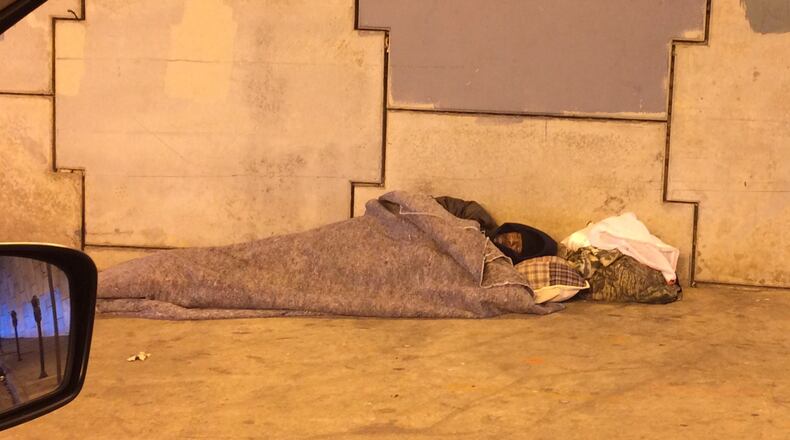Through the gloaming and the cold, blustery winds, I drove around downtown Atlanta on Wednesday with Kem Jackson, a homeless man who pointed out the “cat holes” where his contemporaries dig in for the night.
There were tent cities under highway ramps near I-20, there were a growing number of men setting up under the viaduct near Grady Memorial Hospital, and there were random huddled forms tucked away all over, near fences, in doorways or some just plopped down on sidewalks like they gave up trying.
As the number of downtown pedestrians dropped, the homeless became more noticeable, lugging bags, bedrolls and battered suitcases.
“Look at that guy with a blanket,” said Jackson, pointing at a man wrapped in a sleeping bag, walking around and talking to nobody. “The streets will crack you up. Don’t want to end up like him.”
Even in the homeless community, there’s a pecking order. And the hapless man on Peachtree Street was a cautionary tale.
I met the 57-year-old Jackson near the now closed Peachtree-Pine shelter in Midtown. The massive brick edifice that once housed 500 or more wretched souls each night was finally, after much acrimony, shut down in December of last year.
Jackson said if he could have, he would have slept at Peachtree-Pine that night. “Without a doubt. You could go to the Pine when you had no place to go.”
A year after its closing, I wanted to assess the situation. It was said that closing the large shelter would flood the other facilities and there would be nowhere for many to go on nights when it got cold.
Anecdotal evidence shows the number of homeless people on the sidewalks of downtown and Midtown and on MARTA or at the airport (two places that Jackson haunts) has increased.
However, the official count of homeless people in Atlanta dropped again this year, down 14 percent from 2017 to 3,076, according to a point-in-time census conducted in January. Homelessness in Atlanta has been cut almost in half since 2011, according to city numbers.
There was, however, a slight increase in the number of "unsheltered" homeless, to 732, the first bump in years.
George Chidi, the "social impact director" at Central Atlanta Progress and point man for the closing of Peachtree-Pine, said there may have been reverberations from the Pine's closing. Or maybe because of gentrification and the lack of affordable housing. He said the city also needs a day center for the homeless, the lack of which makes them more visible.
“Tent cities are popping up all over, which is frustrating,” he said. “The people on the bottom are getting bumped into the street. People are pushed into abandoned buildings. Those in abandoned buildings are getting turned out. It’s a cascade down. There’s no place to land.”
Chidi also said, “We are seeing more people who are chronic. We’re seeing more mentally ill.”
Some 40 percent have “serious mental illness” issues and 40 percent have substance abuse problems, according to the city count.
I’d wager it’s higher in both categories.
Chidi noted that Jack Hardin, a lawyer who has been a leader in fighting homelessness since the 1980s, this year started twisting arms to fund outreach teams to go out and build relationships with the homeless.
"It takes a while, a lot of trust-building to get someone to accept help," said Hardin, chairman of the Gateway Center, which was set up by the city to be the official homeless agency. "We probably have a higher incidence of pathologies (people with deep-seated issues) and need to build relationships to help."
Case in point: Will Woods, a homeless man with piles of belongings and survival gear who was getting ready to set up in the tunnel near Grady Memorial Hospital.
“I don’t like shelters, too much drama at shelters. It’s better here on the street,” said Woods, who figured 50 people would set up there. “It got worse when they shut down Peachtree-Pine.”
Hardin said the city has more emergency shelters that open as temperatures plummet. He contests the argument that closing Peachtree-Pine has flooded the streets. “It’s not those people we see on the streets,” he said, “it’s other people.”
He said 255 people were at Peachtree-Pine in August 2017 when social workers came to assess residents there. Almost all, he said, were placed in housing.
However, many people there melted away, not wanting to deal with officialdom. Or somehow they missed out, having been away from the place for a while, like Jackson, my guide.
» RELATED: Torpy at Large: He sang at the White House but still died homeless
Bob Cramer, a tech entrepreneur who was a leader at Peachtree-Pine for years, said the shelter, which had legions of people lining up for beds each night, “was the face of unmet need. It was so visible, it was hard to argue that there was a problem.”
“It’s a shame it was closed; it was a wasted opportunity,” he said. “You can’t let that go, 95,000 square feet that was zoned for it. You can’t get that back in this world of NIMBY.”
As the evening wore on with Kem Jackson, I drove him to a door stoop at a business on a quiet street downtown where he stored gear. A man came out and told him to move it.
We hoisted four garbage bags of stuff and a pull-cart into my minivan. He said he had to pick up his Social Security card at his daughter’s home in Lithonia, 20 miles to the east. He needed it for work at a temp service.
“Sometimes a lot of my stuff is gone. The tramps take it,” he said. “Why would one homeless man steal from another homeless man?”
We drove to Lithonia, where I thought he’d stay for the night. But he merely dumped some of his belongings there, made a phone call, and jumped back into the van. Why didn’t he stay there? Who knows? Probably lots of water under that bridge.
We returned to downtown Atlanta, where he pointed to a bushy outcropping right off the street at the busy Ted Turner Drive. That’s a good spot, he said. I flipped on my blinkers as he unloaded his gear.
Good night, he said. And thanks.
No problem, I responded, as I drove off to a fire awaiting me at home.
About the Author
The Latest
Featured








